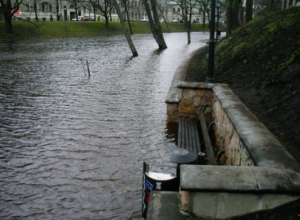
The embankment of the Riga City Canal is underwater due to the large amount of melting snow combined with rain.
RIGA — It was obvious to all that the snowiest winter in nearly a century would bring spring floods, and as the thermometer continues to remain above freezing temperature, Latvia is now facing the harsh reality from one end of the country to another.
Throughout Tuesday reports trickled in hourly about rising waters in villages and towns along the Daugava River and other parts of Latvia. The most serious threat, however, materialized in the Jelgava region, where the Lielupe River was reportedly rising at the rate of an inch or more per hour. Many streets and homes in Jelgava were flooded, though reports indicated that residents refused to evacuate.
Meanwhile, Fire and Rescue Service workers began evacuating residents in the Glūda district (Jelgava region), while Latvenergo issued warnings to all Latvians to exercise caution if their homes are threatened with flood. Elsewhere, 30 houses in Līvāni were under risk of becoming inundated as of Tuesday, while in Kuldiga reports indicated that the water level reached the maximum level. No damage estimates are available yet.
Spring floods are not unusual in Latvia, which has three large hydroelectric dams generate that produce surplus energy during the season due to rising water levels. This year, however, nature’s blessing is shaping up to be a curse given that, according to one report in February, the country saw the most intense snowfall since 1909 and the coldest winter in decades.
The temperature, in fact, remained below freezing for nearly two months straight, turning rivers and lakes into long sheets of ice. But in many parts rivers are still frozen, which is blocking the flow of snowmelt. The problem is occurring throughout Eastern Europe, and Belarusian media reported Tuesday that officials there began dynamiting the West Dvina River to unclog the passage of runoff. Meanwhile Lithuania is also dealing with numerous floods along the Neris and Nemunas rivers.
This article is free to view. To read Baltic Reports’ subscription-only articles, click here.












